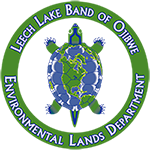 Illegal Burn Barrels
Illegal Burn Barrels
In 2006, the Leech Lake Air Quality Program implemented the Burn Barrel Clean-Up Project.
As of 2008, 60 barrels have been collected. Each household was given two recycling bins to promote recycling and reduce waste in exchange for their burner removal.
The elimination of backyard burning reduces the risk of pollution on the reservation dramatically and recycling can cut household waste in half.
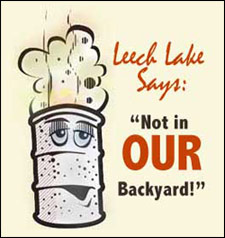 The Leech Lake Air Program continues to work toward developing solutions for removing these pollution producers. You can help our sovereign nation by stopping illegal burning on the reservation and by recycling, reducing, and reusing to lessen the amount of garbage in our environment.
The Leech Lake Air Program continues to work toward developing solutions for removing these pollution producers. You can help our sovereign nation by stopping illegal burning on the reservation and by recycling, reducing, and reusing to lessen the amount of garbage in our environment.
To turn in your burnbarrel call the Leech Lake Air Quality Program at 218-335-7429 or 1-800-442-3942 Monday through Friday.
Do you know the following about Garbage Burning?
- Is not allowed on the Leech Lake Reservation or anywhere in Minnesota
- Harms your family’s health
- Pollutes air, water and soil in your yard and your neighbors
- Causes wildfires 40% of wildfires in Minnesota every year
- Backyard barrel burning of trash is currently a major source of dioxins to the
environment. - In as little as fifteen minutes, 25 feet of soil around your burn barrel will become contaminated with toxic chemicals? Burning household waste or garbage in a barrel or a fire pit in your backyard is twice as harmful as it was
twenty years ago. Burning trash can release:- Lead
- Mercury
- Chromium
- Cadmium
- Many other pollutants
No, burning garbage has been illegal in MN since 1969 and on Leech Lake since 2006. Today’s garbage is made up of more than wood, paper and glass but rather a mixture of synthetics and plastics that release a mixture of cancer-causing chemicals when burned. Backyard burning is the leading source of dioxin emissions that result in many health implications. Dioxin is second in its toxicity to radioactive waste; just 3 ounces would be enough to kill one million people.
What pollution does our garbage emit?
Paper
bleached white paper releases halogenated hydrocarbons, inks and dyes give off toxics, some are coated with plastics to make them shinny, some have plastic windows
Plastic
Plastics is a HUGE source of chlorine & hydrochloric acids.
Heavy metals
Produces arsenic, styrene, barium, mercury, chromium, formaldehyde, hydrochloric acid, lead, nitrogen, and sulfur oxides. Lead can accumulate in blood, bones, and body tissues affecting kidneys, organs and nervous systems.
Styrofoam
Burning styrofoam will release 57 chemical byproducts…wow!
Particulate matter
Its just not smoke: Some particles are small enough to enter the lungs can cause numerous health problems. Particles can aggravate respiratory conditions such as asthma and bronchitis, and have been associated with irregular heartbeats and heart attacks. People with heart or lung disease, the elderly, and children are at highest risk from exposure to particles.
Tires
Tire emissions include particulate matter (PM), carbon monoxide (CO), sulfur oxides (SOx), oxides of nitrogen (NOx), and volatile organic compounds (VOCs) and hazardous air pollutants (HAPs), such as polynuclear aromatic hydrocarbons (PAHs), dioxins, furans, hydrogen chloride, benzene, polychlorinated biphenyls (PCBs) and metals. Many of these compounds can also be found on the St. Regis Superfund Site…they are chemicals of concern.
Ash
Ash from household waste burning contains lead, arsenic, mercury and chromium. All are heavy metals that have known detrimental affects to the body and environment. Do not contaminate your garden by spreading ashes. Garden vegetables can absorb and accumulate these metals, which can make them dangerous to eat. Children playing in the yard or garden can incidentally ingest soil containing these metals. Even if you don’t spread the ashes, rain can wash the contaminates from the ash into groundwater and surface water, contaminating drinking water and food.
I don’t burn my garbage in a barrel, I burn it in a (pit, outdoor stove, fireplace, on the ground, with a pile of leaves….) so I’m not breaking the law.
Wrong. ANY burning of household waste (garbage) is illegal. It is only commonly referred to as burn barrels since that is the most common container method. That is why the term backyard burning is used to capture all forms of residential household waste burning.
What can I do? What options do I have?
- Turn your burn barrels or properly dispose of it.
- If you are a Leech Lake member we will dispose of it for you and give you 2 recycling bins.
- Larger transfer stations will take the ash and the barrel can be recycled for the metals.
- Start recycling
- You will see how much is really waste and what can be recycled and used again. This will also save on garbage fees.
- Recycling is the number one thing everyone can do to make a change in global warming.
- Make your own bins, use laundry baskets or bags to collect items.
- Recycling centers and drop off points are readily available. (link here to to directly to list of drop off sites/transfer stations by community/county)
- Reuse items
- Turn old/damaged clothes into rags for the house or garage.
- Reuse those plastic utensils, they’re still good for the next picnic.
- Repair, sell, or donate used or unwanted items.
- Don’t buy the plastic wrapped cartons or boxes within boxes.
- Do all your fruit and veggies really need separate plastic bags for the checkout counter? Wave off the bags and save some waste.
- If you have no other option recycle as much of the packaging as possible.
- Buy recycled products, they are just as effective and take less resources to make.
- Make a compost. Dispose yard trimmings, food and other organic wastes while making great food for your garden or flower beds!
- Properly Dispose. Have your garbage collected (most are reasonable and also pick up recyclables) or bring it to a transfer site. (link here to to directly to list of drop off sites/transfer stations by community/county)
Backyard Trash Burning vs. Municipal Incinerator
Burning garbage in your backyard poisons the air you and your family breathe directly! Dioxins found in emissions from backyard burning are a potent human carcinogen and are formed from carbon and chlorine (found in plastic) when burned. Because municipal incinerators have pollution control technology, the hazardous pollutants are captured instead of being emitted. In addition, burning garbage in municipal incinerators has a higher temperature in which household garbage is burned at, allowing for a reduction in the formation and emissions of air pollutants.
What we are actually doing to our health?
Dioxins are potential endocrine disruptors, a chemical which interfere with reproductive, developmental, behavior and affect our immune systems. (Endocrine disruptor chemicals are used to kill cockroaches.) Other health problems when burning your waste result in respiratory illnesses, nervous system, kidney and liver damage. Particle matter, in the form of microscopic airborne soot, can irritate your lungs and eyes and potentially get into your blood stream because of its small particle size. Since dioxins are lipophilic (fat-loving) dioxins can accumulate in your bodies over time (bioaccumulation).
What goes up must come down.
Dioxins released into the air from burning garbage will eventually fall onto the crops that farm animals consume. When we eat the fats in food products from animals raised on those plants we slowly ingest these dioxins.
Dioxins also enter our lakes and rivers when these air borne toxins mix with raindrops falling back onto our Earth’s surface. We then again are exposed to dioxins by the adhesion of these particles to fruit and vegetable plant surfaces which can accumulate in the fatty parts of fish and livestock. (art: raincloud with some nasties in it….)
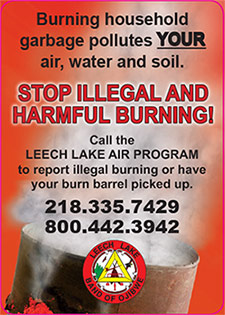 My neighbor burns garbage, what can I do, its their property?
My neighbor burns garbage, what can I do, its their property?
Burning garbage is illegal regardless of who’s property.
1. You could ask the neighbor to stop and give them some facts. Most do not know the dangers of burning or the chemicals given off.
2. Contact your local authorities or fire warden. Leech Lake Conservation Officers, Minnesota Department of Natural Resources Officers, peace officers can all inform the burner to stop all burning, have them remove the barrel, and issue them a warning or ticket for burning garbage. You can also contact our office and we will help you educate and go through the proper channels of having the barrel removed.
Sign up to have your barrel properly disposed of!
Contact the Leech Lake Air Program at 218-335-7429 to schedule a pickup and an exchange of your barrel(s) for two recycling bins.
Collecting a burn barrel from a Leech Lake Reservation resident.
Burn barrels present other dangers as with this location next to a propane tank.
Local burn of a large pile of garbage and platics in a residential area.
Leech Lake Air Monitoring Projects
The Chatfield Air Site was established in June 2002. This site was chose due to tribal land, its remoteness, ground cover, setback from the trees and road, and lack of industry, housing, or other related activities. Finding a site that fit the criteria for all the different parameters of monitoring was a challenge but found with the Chatfield property.
The Leech Lake PM Monitoring Project has been operational since January 2003. The project was started to establish a background level of particulate matter for the Leech Lake Reservation and surrounding area. The monitors collect particulate matter in the 2.5 micron range, matter that can reach deep into our lungs. Samples are taken every 6 days. We have not exceeded the PM standards to date but have had some interesting readings. To date the Leech Lake PM Project is the only long-term particulate monitoring project in the northern tier of Minnesota.
The Leech Lake Air Program has partnered with the Tribal Air Monitoring Support Center (TAMS) in Las Vegas, Nevada to weigh and report on the filters used for monitoring. Data from the project is contributed to a national database for air quality parameters, the Air Quality System. This database provides ambient air monitoring data of criteria and hazardous air pollutants at monitoring sites. The following link can assist you in searching the AQS database:
http://www.epa.gov/ttnairs1/airsaqs/detaildata/requestingaqsdata.htm
Mini-Vols can be used for source specific or general air sampling. Our two previous projects with the Mini-Vols have been with the Big Lake Lake Association and the Advanced Science Students at the Cass Lake-Bena Middle School. The Big Lake project sampled for 1.5 years to collect data from transport onto the reservation from the northwest direction. The Middle School students sampled for 6 months during their school year. This project was to collect data both for background and transport pollution on the Reservation and to introduce young scientists to research and monitoring.
What is PM (Particulate Matter)? Particles released into the air in the form of fine liquid or solid particles such as dust, smoke, mist, fumes or smog.
Fine particle pollution or P.M. 2.5: Refers to particulate matter that is 2.5 microns in size or smaller. On average PM 2.5 is 1/30th the diameter of a human hair. These particles are harmful because they are small enough to get trapped deep inside of your lungs and/or bloodstream causing respiratory or cardio problems including reduced lung function, the development of chronic bronchitis, and even premature death. Fine particles; include all types of combustion activities (motor vehicles, power plants, wood burning etc.) and certain industrial processes.
Coarse particle pollution: is made up of particles that are larger than 2.5 microns but no larger than 10 microns. These particles are harmful because they are known to exacerbate asthma, aggravate lung disease, irritate the eyes, nose, throat and may also increase susceptibility respiratory infections. Coarse particles are made up of sources that include grinding operations, dust from paved or unpaved roads, wind blown dust etc.
http://www.epa.gov/ebtpages/airairpollutantsparticulatematterpm.html
How do these particles affect us? Numerous scientific studies have linked particle pollution exposure to a variety of problems including:
- Irritation of airways, coughing or difficulty breathing
- Decreased lung function
- Aggravated asthma
- Development of chronic bronchitis
- Irregular heart beat
- Heart attacks and premature death in people with heart or lung disease.
- People with heart or lung disease, children and older adults (sensitive populations) are susceptible to particle pollution exposure. However, even if you are healthy, you may experience temporary symptoms from exposure to elevated levels of particle pollution.
http://www.epa.gov/ebtpages/airairpohealtheffects.html
Printables
Call us to turn in your burn barrel or more information:
Division of Resource Management Air Program (218) 335-7429.
To reprot illegal burning call the Leech Lake Conservation Enforcement Department at (218) 335-7400 or 1-800-442-3942 toll-free.
Download the Leech Lake Band of Ojibwe Division of Resource Management
Burn Ordinance > Click here for pdf
Links to solid waste sites:
Leech Lake Solid Waste Department
Call 335-4160
Hubbard County
http://co.hubbard.mn.us/PublicWorks/SolidWasteQA.htm
http://co.hubbard.mn.us/PublicWorks/SolidWaste.htm (just solid waste)
Beltrami County
http://www.magnusontrucking.com/
Itasca County
http://www.co.itasca.mn.us/
Cass County
http://www.co.cass.mn.us/esd/solid_waste/recycling.html















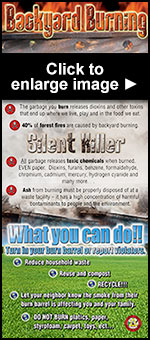
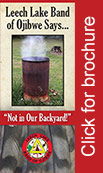
 Division of Resource Management
Division of Resource Management